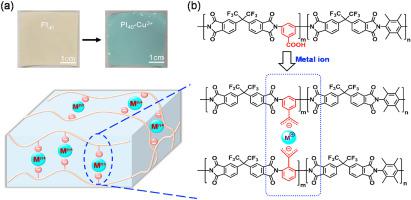Journal of Membrane Science ( IF 8.4 ) Pub Date : 2020-12-26 , DOI: 10.1016/j.memsci.2020.119002 Xiaofan Luo , Zhenggong Wang , Shanshan Wu , Wangxi Fang , Jian Jin

|
The strategy of chemical cross-linking has been well used in the system of polyimide membranes for organic solvent nanofiltration (OSN). However, this method significantly affects the permeability and mechanical properties of polyimide membranes, as the opening of imide bond during the chemical cross-linking reaction damages the original polymer backbone structure. This work presents the formation of a new generation of OSN membranes through facile metal ion cross-linking of integrally skinned asymmetric polyimide membranes. A type of specially designed polyimide is synthesized with carboxyl functional groups introduced into the polymer backbone as organic ligands, and metal ion coordination cross-linking reaction takes place between the functionalized polyimide membranes and metal ions. Especially, the Cu2+ ion cross-linked polyimide membranes exhibit good stability in a variety of organic solvents including toluene, DMF, acetone, methanol, acetonitrile, etc., with >99% rejection to Coomassie brilliant blue (MW = 854) in acetone. Meanwhile, no significant attenuation of membrane permeability is observed after the cross-linking, as the metal ion does not occupy as much free volume as traditional chemical cross-linkers. Furthermore, the metal ion cross-linking is found to greatly improve the compaction resistance of the membrane due to the enhanced polymer-chain rigidity. This work confirms the feasibility of ion coordination based polymeric membranes for organic solvent separation applications and provides a brand-new route for the fabrication of OSN membranes with unique advantages.
中文翻译:

具有改善的有机溶剂抗性的金属离子交联纳米多孔聚合物膜,可用于分子分离
化学交联策略已广泛用于有机溶剂纳米过滤(OSN)的聚酰亚胺膜系统中。然而,该方法显着影响聚酰亚胺膜的渗透性和机械性能,因为在化学交联反应期间酰亚胺键的打开会破坏原始的聚合物主链结构。这项工作介绍了通过整体蒙皮的不对称聚酰亚胺膜的易金属离子交联形成新一代OSN膜的方法。合成一种特殊设计的聚酰亚胺,其中羧基官能团作为有机配体引入到聚合物主链中,并且在官能化的聚酰亚胺膜和金属离子之间发生金属离子配位交联反应。特别是Cu 2+离子交联的聚酰亚胺膜在多种有机溶剂(包括甲苯,DMF,丙酮,甲醇,乙腈等)中显示出良好的稳定性,并且对丙酮中的考马斯亮蓝(MW = 854)的排斥率大于99%。同时,在交联之后没有观察到膜渗透性的显着降低,因为金属离子没有占据传统化学交联剂那么多的自由体积。此外,由于增强的聚合物链刚性,发现金属离子交联极大地改善了膜的抗压实性。这项工作证实了基于离子配位的聚合物膜在有机溶剂分离应用中的可行性,并为制造具有独特优势的OSN膜提供了一条崭新的途径。


















































 京公网安备 11010802027423号
京公网安备 11010802027423号